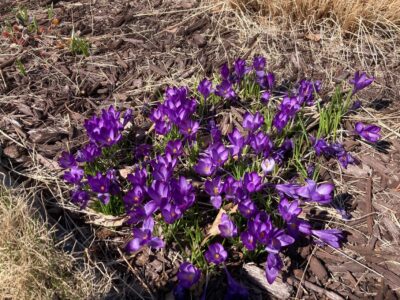By: Matthew Olson
March 28th 2022
Spring Blooming Bulbs

I often hear the phrase “April showers bring May flowers”. These words remind us that spring is coming. However, we don’t have to wait until May to see flowers in the landscape. Many spring bulbs begin blooming during April, even in Minnesota. Bulbs provide a wonderful pop of color in the landscape when other plants are just waking up. Bulbs are versatile, and come in a wide variety of color, shape, and size, giving us many ways to use them in the garden. We’ll look at commonly grown bulbs in the landscape and how to use them.
Daffodil (Narcissus)
Daffodils are immensely popular, for several reasons. They’re extremely easy to grow and very hardy, returning year after year. The bright yellow flowers of Daffodils stand out against the brown landscape, making them even more attractive. Daffodils come in many colors, such as pink, white, bicolor, and other shades of color. In fact, over 25,000 cultivars of daffodils exist. Some cultivars bloom at different times, allowing a succession of bloom throughout spring. Daffodil cultivars come in different sizes as well, from miniature flowers to large double flowering cultivars. One benefit of daffodils is their ability to resist damage from deer and other critters. The bulbs are poisonous to animals, making them less desirable for eating.

Tulip (Tulipa)
Tulips have a rich history in the gardening world, from being used in ancient art and gardens, to becoming a form of currency at Dutch flower markets in a period known as Tulip Mania. People around the world love using this flower to enhance their gardens. Unlike Daffodils, most tulips in Minnesota are treated as annuals or short-term perennials. The smaller tulip species are most suitable for perennial tulip plantings. Tulips have an array of different flower colors, but also flower shapes. Some varieties have unique ruffled petals, while others have lily shaped flowers. A succession of bloom can be created using different cultivars, providing color from mid spring until early summer. One thing to note is deer can be attracted to the flower buds. Repellents should be applied when the tulips begin emerging in spring to minimize deer problems. Tulips are a great choice for both formal and informal gardens.
Hyacinth (Hyacinthus)
This mid spring bloomer is easy to recognize by its distinct fragrance and spheres of colorful flowers. Hyacinth is considered a short-term perennial, as the plants tend to fade after a couple years. Hyacinth is frequently grown in mass plantings along the edge of the garden where people can enjoy their fragrance. They come in a variety of colors, allowing them to look stunning when planted in mixed or single-color plantings.
Minor Bulbs
Minor bulbs are small but create a major impact in the spring garden. A few examples of minor bulbs are crocus, snowdrops, and winter aconite. These bulbs are the first flowers to bloom in spring, marking the end of winter. Snowdrops bloom first, often before the snow has fully melted. The white flowers of snowdrops are easiest to spot when planted in large clumps. Winter aconite blooms around the same time as snowdrops. These bulbs feature yellow flowers that brighten the early days of spring. Aconite and snowdrops will naturalize overtime if grown in the right conditions. Crocuses are my personal favorite among minor bulbs. They come in a variety of colors and begin blooming as the snowdrops and aconite fade away. Crocuses are easier to find in stores than snowdrops and winter aconite, making them easier to obtain. You can grow either snow crocus or Dutch crocus. Snow crocus bloom slightly earlier and feature smaller flowers than Dutch crocus.
You may be familiar with the perennial Iris that are commonly grown in Minnesota and bloom in early summer, but there’s Iris that bloom in early spring as well, called “Iris reticulata“. This iris only grows 4-6 inches tall. However, the flowers still feature the unique look of the more common iris species. “Iris reticulata” requires soil with sharp drainage to thrive.
Designing with Bulbs
Bulbs can be used in a variety of ways. To create maximum impact in the garden, it’s best to plant bulbs in groups of 10-15, adding several groups of plantings to draw the eye throughout the garden. Planting in groups gives the planting a natural look as well. As the bulbs finish blooming, the remaining foliage may appear undesirable. One way to minimize this problem is to plant among other perennials and shrubs. As the perennials emerge, the bulb foliage will blend into the background.
Each type of bulb only blooms for a few weeks. However, with some planning you can have bulbs blooming for 8-10 weeks during the spring. Creating a succession of bloom will keep your garden looking attractive from now until summer. Incorporating minor bulbs will give you the earliest blooms, beginning in late March- early April, depending on the weather. Once these bulbs finish blooming, the daffodils and hyacinth take over, carrying the wave of color. Tulips and other late spring bulbs finish the succession of blooms as summer draws near.
Bulbs are an effective way to end the winter months and bring spring into the garden. The wide variety of bulbs available give us unlimited opportunity to showcase these harbingers of spring. I encourage you to visit some local gardens to observe how they use these plants to enhance their spring displays. You may even find some ideas for your own landscape. Happy gardening!

